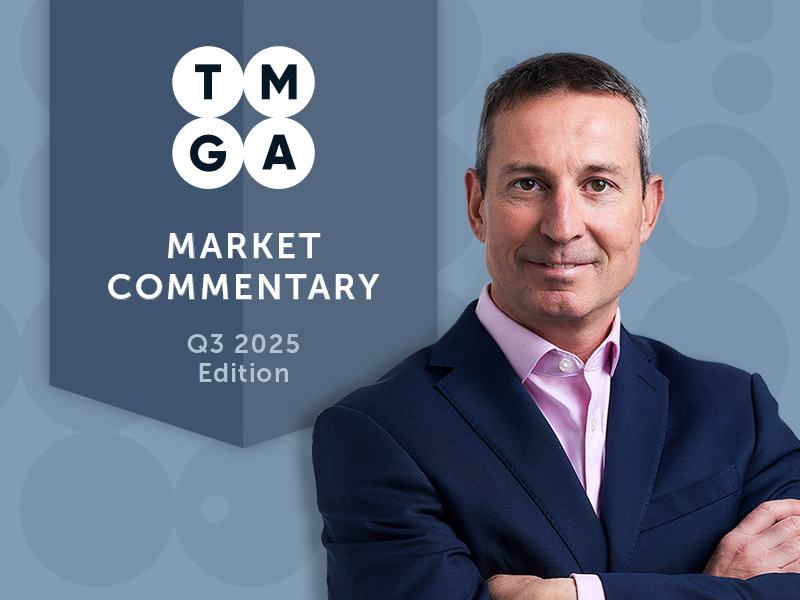

Despite limited immediate impact from tariffs, recession concerns have grown amid a softening labour market. Markets are now pricing 0.75% of Fed rate cuts over the next year, following the recent 0.25% cut, the first since December 2024, with the Fed signalling two more cuts in 2025. Average US tariffs have surged to over 15% from 2.3% in 2024, the highest since WWII, with US inflation forecasts rising to 3%. While the Fed Chair, Jerome Powell views tariff-driven inflation as temporary, we see increased inflation risks which could constrain further rate cuts, risking further challenges to Fed independence from the Trump administration. This would put pressure on elevated US valuations, particularly following a renewed technology-led rally. That said August inflation held steady at 2.7%, helping sustain market momentum.
FTSE 100 hits record highs, driven by banks, industrials, oil, and rising overseas investor interest.
In the UK, the FTSE 100 has outperformed Europe despite domestic headwinds. The Autumn Budget is on November 26th, and recent figures showed government borrowing surging to the highest level since the pandemic, likely to prompt higher taxes. The Bank of England held rates at 4%, with Governor Andrew Bailey cautioning that the UK economy remains vulnerable to entrenched inflation (currently at 3.8%) and subdued growth. Consequently, rates are expected to stay flat through year-end, with the next cut likely in early 2026 when inflation is expected to trend back towards 3%.
The FTSE 100 recently hit record highs, buoyed by the strength in banks, industrials, and oil – sectors which are now acting as tailwinds. Overseas investor interest is rising, driven by attractive valuations, recent trade deals, and a robust cash yield enhanced by record share buybacks. Notably, the UK secured £150 billion in US investment during Trump’s state visit and now enjoys a 5% relative tariff advantage over Europe.
In Europe, the ECB had led rate cuts with inflation more controlled than the US and UK, but the Euro Stoxx 50 lagged strong US and UK performance during Q3. This underperformance may present a buying opportunity, supported by substantial monetary and fiscal stimuli and a pledge to raise defence spending to 5% of GDP by 2035. Though above the UK’s 10% US tariff rate, Europe’s baseline rate settled at 15%, far below the threatened 30%, aided by the EU’s $600 billion investment commitment in the US.
Emerging markets benefit from dollar weakness, Chinese reforms, and diversification away from US assets.
Chinese equities continued to rebound from previously oversold levels. The introduction earlier this year of government reforms aimed at improving corporate governance combined with several equity market specific policies aimed at stabilising prices has boosted investor confidence with the Shanghai Index up 18% year to date. Furthermore, securing a trade deal with the US has reduced uncertainty and although US exports have fallen, Chinese exports to the rest of the world are up significantly underscoring China’s shifting trade relationships. Emerging markets stand to benefit from US dollar weakness, genuine Chinese policy reform and investors starting to diversify away from US assets.
Gold continues to reach record highs, driven by central banks ongoing purchases seeking to diversify foreign reserves, as well as benefitting from falling interest rates and ongoing inflation concerns. It remains a key portfolio hedge amidst loose fiscal policies and geopolitical and financial instability.
Although fixed income is susceptible to inflation risks, investors are rewarded by attractive yields. Our exposure remains below benchmark duration meaning we maintain lower interest rate risk than the market. Meanwhile healthcare remains in the doldrums, but the current weakness is the third significant pullback in four decades, which has historically been a good entry point and should be relatively defensive if we witness general market volatility.
Sterling has strengthened amid dollar weakness, with the Trump administration’s “US first” stance prompting global investors to reduce dollar exposure. Notably, the dollar failed to rally during the Iranian crisis in June or maintain the brief July dollar rally, reinforcing our decision to maintain significant portfolio hedging.
Looking ahead, equity markets may witness volatility following the strong rally from April lows, especially if poor inflation data delays anticipated Fed cuts, unsettling investor sentiment. While Q3 saw broad equity gains, technology led the charge making US markets more vulnerable in a pullback. In contrast, valuations in Europe, the UK, and emerging markets remain more attractive. We continue to advocate portfolio diversification and increased cash levels to capitalise on potential market weakness following the strong rally since April lows.
Please note that the value of investments and the income derived from them may fluctuate from time to time.




